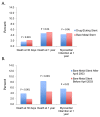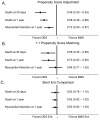Accounting for the mortality benefit of drug-eluting stents in percutaneous coronary intervention: a comparison of methods in a retrospective cohort study
- PMID: 21702899
- PMCID: PMC3141543
- DOI: 10.1186/1741-7015-9-78
Accounting for the mortality benefit of drug-eluting stents in percutaneous coronary intervention: a comparison of methods in a retrospective cohort study
Abstract
Background: Drug-eluting stents (DES) reduce rates of restenosis compared with bare metal stents (BMS). A number of observational studies have also found lower rates of mortality and non-fatal myocardial infarction with DES compared with BMS, findings not observed in randomized clinical trials. In order to explore reasons for this discrepancy, we compared outcomes after percutaneous coronary intervention (PCI) with DES or BMS by multiple statistical methods.
Methods: We compared short-term rates of all-cause mortality and myocardial infarction for patients undergoing PCI with DES or BMS using propensity-score adjustment, propensity-score matching, and a stent-era comparison in a large, integrated health system between 1998 and 2007. For the propensity-score adjustment and stent era comparisons, we used multivariable logistic regression to assess the association of stent type with outcomes. We used McNemar's Chi-square test to compare outcomes for propensity-score matching.
Results: Between 1998 and 2007, 35,438 PCIs with stenting were performed among health plan members (53.9% DES and 46.1% BMS). After propensity-score adjustment, DES was associated with significantly lower rates of death at 30 days (OR 0.49, 95% CI 0.39 - 0.63, P < 0.001) and one year (OR 0.58, 95% CI 0.49 - 0.68, P < 0.001), and a lower rate of myocardial infarction at one year (OR 0.72, 95% CI 0.59 - 0.87, P < 0.001). Thirty day and one year mortality were also lower with DES after propensity-score matching. However, a stent era comparison, which eliminates potential confounding by indication, showed no difference in death or myocardial infarction for DES and BMS, similar to results from randomized trials.
Conclusions: Although propensity-score methods suggested a mortality benefit with DES, consistent with prior observational studies, a stent era comparison failed to support this conclusion. Unobserved factors influencing stent selection in observational studies likely account for the observed mortality benefit of DES not seen in randomized clinical trials.
Figures



Similar articles
-
Safety and effectiveness of drug-eluting stents versus bare-metal stents in elderly patients with small coronary vessel disease.Arch Cardiovasc Dis. 2013 Nov;106(11):554-61. doi: 10.1016/j.acvd.2013.06.056. Epub 2013 Nov 11. Arch Cardiovasc Dis. 2013. PMID: 24231052
-
The Role of Vascular Imaging in Guiding Routine Percutaneous Coronary Interventions: A Meta-Analysis of Bare Metal Stent and Drug-Eluting Stent Trials.Cardiovasc Ther. 2015 Dec;33(6):360-6. doi: 10.1111/1755-5922.12160. Cardiovasc Ther. 2015. PMID: 26363283 Review.
-
Two-year outcomes after first- or second-generation drug-eluting or bare-metal stent implantation in all-comer patients undergoing percutaneous coronary intervention: a pre-specified analysis from the PRODIGY study (PROlonging Dual Antiplatelet Treatment After Grading stent-induced Intimal hyperplasia studY).JACC Cardiovasc Interv. 2014 Jan;7(1):20-8. doi: 10.1016/j.jcin.2013.09.008. Epub 2013 Dec 11. JACC Cardiovasc Interv. 2014. PMID: 24332420 Clinical Trial.
-
Drug-eluting stents compared to bare-metal stents improve short-term survival in patients with acute myocardial infarction undergoing primary percutaneous coronary intervention: a nationwide prospective analysis of the AMIS Plus registry.Kardiol Pol. 2014;72(4):315-23. doi: 10.5603/KP.a2013.0346. Epub 2013 Dec 2. Kardiol Pol. 2014. PMID: 24293144 Clinical Trial.
-
Drug-Eluting Versus Bare Metal Stents in Saphenous Vein Graft Intervention: An Updated Comprehensive Meta-Analysis of Randomized Trials.Cardiovasc Revasc Med. 2019 Sep;20(9):758-767. doi: 10.1016/j.carrev.2018.11.013. Epub 2018 Nov 22. Cardiovasc Revasc Med. 2019. PMID: 30503811
Cited by
-
How to control for unmeasured confounding in an observational time-to-event study with exposure incidence information: the treatment choice Cox model.Stat Med. 2017 Oct 15;36(23):3654-3669. doi: 10.1002/sim.7377. Epub 2017 Jul 4. Stat Med. 2017. PMID: 28675922 Free PMC article.
-
Impact of drug-eluting stents on the comparative effectiveness of coronary artery bypass surgery and percutaneous coronary intervention.Am Heart J. 2015 Jan;169(1):149-54. doi: 10.1016/j.ahj.2014.10.004. Epub 2014 Oct 25. Am Heart J. 2015. PMID: 25497260 Free PMC article.
-
How real can we get in generating real world evidence? Exploring the opportunities of routinely collected administrative data for evaluation of medical devices.Health Econ. 2022 Sep;31 Suppl 1(Suppl 1):25-43. doi: 10.1002/hec.4562. Epub 2022 Jun 28. Health Econ. 2022. PMID: 35762465 Free PMC article.
-
Symptomatic intracerebral hemorrhage after non-emergency percutaneous coronary intervention: Incidence, risk factors, and association with cardiovascular outcomes.Front Cardiovasc Med. 2022 Sep 16;9:936498. doi: 10.3389/fcvm.2022.936498. eCollection 2022. Front Cardiovasc Med. 2022. PMID: 36186990 Free PMC article.
-
Evaluating the effectiveness of a rapidly adopted cardiovascular technology with administrative data: the case of drug-eluting stents for acute coronary syndromes.Am Heart J. 2012 Aug;164(2):207-14. doi: 10.1016/j.ahj.2012.05.016. Am Heart J. 2012. PMID: 22877806 Free PMC article.
References
-
- The American Recovery and Reinvestment Act of 2009. H.R.1.ENR. http://www.recovery.gov/About/Pages/The_Act.aspx (Accessed July 4, 2011)
-
- Rubin DB. Estimating causal effects from large data sets using propensity scores. Ann Intern Med. 1997;127:757–763. - PubMed
Publication types
MeSH terms
LinkOut - more resources
Full Text Sources
Medical
Miscellaneous

